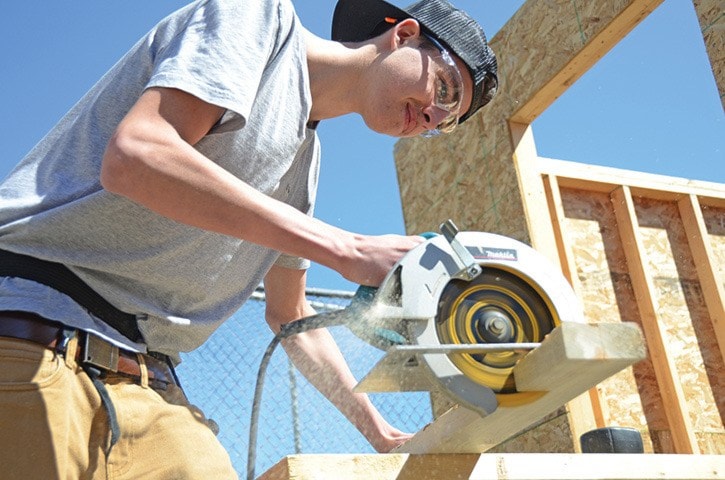We walk out the back doors from the administration area of Belmont secondary and into the yard. To the left is a fenced in area containing three large, partially built sheds.
They're not really what you normally think of as a shed, though, because they're being built as if they were houses. They are framed and covered to standards above residential building code. They're just small. One is eight-feet by eight-feet, another is 10-by-10 and the third is 12-by-12.
This is where the Belmont construction students do their work, under the supervision and instruction of a Red Seal carpenter who holds a bachelor's degree in education. That isn't someone you come across every day. Fortunately for the Sooke School District, they have one in Jason Leslie, who teaches the construction courses at Belmont.
"I've had to make the program very individualized for each student to work around their academic needs," Leslie says as we approach the area. That involves creating individual timetables for each student, working with them to find the best placement in the work force while pursuing their individual career goals.
As a long-time framer and construction worker himself, Leslie is uniquely qualified to help give these students a head start on their career or work goals. When students complete construction courses at Belmont, they have more than just a cursory knowledge of how to swing a hammer, that's for sure.
"You're trying to mimic what they're going to see in the real working world," he says. "We're mimicking residential construction. I don't want to set them up for failure. I want them to learn, but I also want them to be stepping on the job site with a basic knowledge of the terminology, the expectations and the basic skills."
It seems to be working. Vice-principal Mike Huck – who spearheaded the reworking of the program two years ago and will take it with him to Royal Bay this fall – says all but two of the current batch of kids are employed in a job related to what they're pursuing. Many past students are well on their way to accomplishing their apprenticeships.
 Grade 12 student James Pitman-Jelley believes the program will, indeed, give him a leg up in the job market.
Grade 12 student James Pitman-Jelley believes the program will, indeed, give him a leg up in the job market.
In fact, it already has. He recently received a job offer from a local electrician which will see him employed as of the end of April.
"It gives us both a great learning experience and practice doing real building," Pitman-Jelley says. He also thinks it will give students who are interested in working with their hands, but may be unsure which field they want to go into, help to narrow that focus. While building sheds doesn't directly introduce students to electrical or plumbing work, the certifications they receive in the program – such as Occupational First Aid (OFA), site safety, and others – allow them to pursue opportunities in whichever fields they'd like to try, in shorter "work experience" opportunities.
"These are qualifications that employers really like to see on a resume," Leslie said. "When they see you've already got OFA on there, it goes right on the top of the pile."
And Belmont helps them get their foot in the door with employers, as well.
"Pretty much every company we work with says really good things about our kids," Huck says. "The way that we broach the subject is we say, 'look, try this kid out for two or three weeks as a work experience, and if you like them, then we can work something out in terms of a paid employment and apprenticeship arrangement. And almost every time, they complete that 30-hour work experience and it morphs right into an apprenticeship. I see kids daily, when I go to the high schools being built, who came through here."
Roger Hargreaves, career program co-ordinator for the Sooke School District, couldn't be happier with the program.
"It's awesome," he says. "It gets them skilled up to a certain degree, they get a bunch of safety certifications that the employers are looking for people to have on the job site, and then it helps them find jobs while they're learning. For them to be able to start their apprenticeship while they're they're still in high school, that's a huge leg up."
Building materials are expensive, so in order to help fund the program, they sell the finished products once they're completed.
A 10-by-10 shed produced by the program sells for $1,450. "It's just to recover the costs and sustain the program," Leslie says.
The sheds are sold at the cost of materials, plus 15 per cent. That additional cost covers things like saw blades, hand tools, extension cords, air compressor hoses, work belts and other non-building material items that the program needs to continue.
"It's not a profitable program," Leslie says, chuckling, "but we need it to be able to sustain itself. I'm not going to name specific competitors or anything, but let's just say there are way smaller ones for sale right now for $1,099 that are going to blow over in the wind." He sees their products as having some real value to people in the community.
The units start at about $1,000 for an eight-by-eight, and all shed purchases include dismantling, delivery and re-construction on the purchaser's property under the supervision of Leslie. Contact him at 250-478-5501 or Huck at 250-478-5501 (ext. 307) to view the sheds or for more information.
Oh, and the kids learn the basics by building dog houses, so if you know someone who needs a home for a furry friend, call them to check those out, as well.
